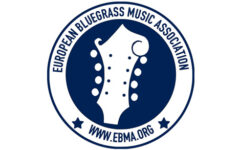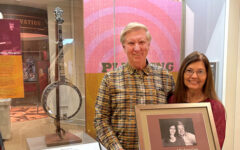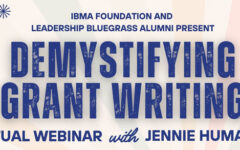
CBA Bluegrass Breakdown editor/graphic designer, Jason and Gina Dilg
Long-time readers of the California Bluegrass Association member’s monthly newsletter, the Bluegrass Breakdown, noticed big changes during the pandemic including a smaller footprint with fewer columns with a professional-looking glossy print finish, but as the familiar song lyric goes, “That’s all in the past dear, it didn’t seem to last.” I spoke to CBA chairman Pete Ludé, and new Breakdown editor/graphic designer, Jason and Gina Dilg, to hear what readers can look forward to.
It’s important to credit the late Mark Varner for his long-term, extensive work in putting together an amazing and award-winning newsletter. After Mark’s departure, CBA member Patrick Campbell stepped up as editor when resources were scarce, and kept things going. Now to the Q&A.
Hello Pete. Tell us about the changes and your vision for the CBA Bluegrass Breakdown.
At the start of the pandemic, CBA – like most organizations – faced some unexpected financial challenges and tough choices. Since in-person communication became so difficult, we decided to focus on digital communication. We scaled back the Bluegrass Breakdown and began producing regular webcasts, expanded social media, and an entirely new website and membership management system. When we emerged from the tough times in good shape, the CBA board decided it was time to beef up the Bluegrass Breakdown as a high-quality print publication. The Breakdown has been continuously published as a monthly publication since 1975, so it has a rich history and a lot of fans. Beginning this January, we went from the scaled-back 4-page format, to 12 to 16 pages to include more compelling long-form stories. We’ve received encouraging feedback from both our membership and advertisers.
To accomplish this vision, CBA went on a search to find an editor and graphic designer to create a fresh, fun, and accessible publication. We were very fortunate to find Jason and Gina Dilg, who took over this role last October, and have brought a new and exciting perspective to the newsletter. In the process, it became clear that there are many untold stories about the people who pioneered bluegrass and old-time music here in California, and about the vibrant current scene of musicians, luthiers, songwriters, and so much more. It is important to tell these stories, and now with our new team and expanded publication, we have a platform to do it.
How can people get a physical copy or a link to read online?
The best way is to become a member of the California Bluegrass Association, and you’ll get the paper or digital version each month. Membership is still only $25 per year for individuals, or $30 for your whole family, plus many other benefits which you can find out about at www.CaliforniaBluegrass.org. For now, non-members can also access the digital (pdf) version of the Bluegrass Breakdown by looking for the orange Bluegrass Breakdown button on the web site home page.
Hey Jason. How did you get into BGOT music?
I was a recovering classical violin dropout when I saw a production of the play, A Lie Of The Mind, at James Madison University in Harrisonburg, VA, way back in 1991. The music, originally scored by the Red Clay Ramblers, was performed that night by local musicians on mandolin family instruments. I was entranced by the music — I don’t really remember the play!
Jason on Banjo at the Lyons, Colorado Old-Time Square Dance
What excites you about working on the CBA Breakdown?
So many things.
It’s an exciting time to be here! We’re all shaking off a few years of social isolation from COVID. I think it’s interesting that the Bluegrass Breakdown’s founder — also CBA’s co-founder and first member, the recently passed Carl Pagter — knew this publication would be essential to bringing together bluegrass musicians across such a big state when he started the organization. So we’re using the Breakdown and the advantages that longer format stories than social media can easily accommodate to help us reconnect to each other and live music — jams and performances — which is an ethos that has run through CBA from its inception. It’s exciting to be a part of that, and I hope that’s reflected in the content and tone that we’re setting as we expand the publication from the four-page newsletter it became during the pandemic.
We’re also highlighting the trends and changes in the community and the broader bluegrass world, including a “big tent” view of the music in line with Carl’s vision, and our mission. We’ll be diving deep into old-time, gospel, and other forms of early American folk; shining the light on the role of nonwhite and female musicians past and present; and documenting the inspiration and love that pours from this community year after year from programs like the CBA Campouts, Youth Program, and the famous Father’s Day Festival in Grass Valley. I’m excited to be doing some of this writing and also working with other great writers from the industry in this work.
Hi Gina. What is your musical connection to old-time/bluegrass music?
I’ve actually been involved with old-time and bluegrass music since I was little and living in Albuquerque NM. My folks were learning banjo and fiddle, and gave my sister and I fiddle lessons and drove to the East Coast for fiddlers conventions every summer, listening only to old-time string band music the whole time. They had square dance band practices in the house every week growing up. I went to college in Fredericksburg, Virginia, which was a music community heavily influenced by the Seldom Scene, and then moved to Colorado where I was quickly immersed in the music there. I loved that I could bounce between old-time and bluegrass music, and living in Lyons surrounded me with some of the best musicians in the business, and put me right at the heart of the Rockygrass festival.
Here is Gina fiddling at the 2018 Floyd Get Together Square Dance with Tatiana Hargreaves and Allison DeGroot
Talk about your trad music art and how that might influence your work on the Breakdown.
The layout work for the Breakdown comes fairly easily after my work for the Floyd Country Store and County Sales, and I love to create appealing aesthetic pieces that help tell a story. I imagine though when you say “trad music art” you might be referencing the illustrative series I started during the pandemic that took off as a sticker and merch phenomenon. We got caught up in Casper, Wyoming for three weeks in midwinter of 2020, and without a whole lot to do, I created three illustrations of Benton Flippen, Ola Belle Reed, and Jean Ritchie, and ordered them as stickers. Since then I’ve added 14 other illustrations of traditional music artists and put them on everything from shirts to keychains and magnets. I’m not entirely sure how this will influence my work on the Breakdown, but I hope that it allows me to envision engaging ways to create and arrange content that works in harmony with the great articles from our writers and editor.
To conclude, Jason had this to say about upcoming issues of the Breakdown.
Each issue of the Breakdown is crafted around a central theme — in the spring we’ll preview the 2023 Father’s Day Festival in Grass Valley and spotlight CBA’s youth programs; this summer we’ll profile some of California’s amazing luthiers — with original articles and interviews giving the reader a fresh, well-rounded perspective on the many facets of this music and community.
Here’s a memory and preview of this years festival headliner, Molly Tuttle.







